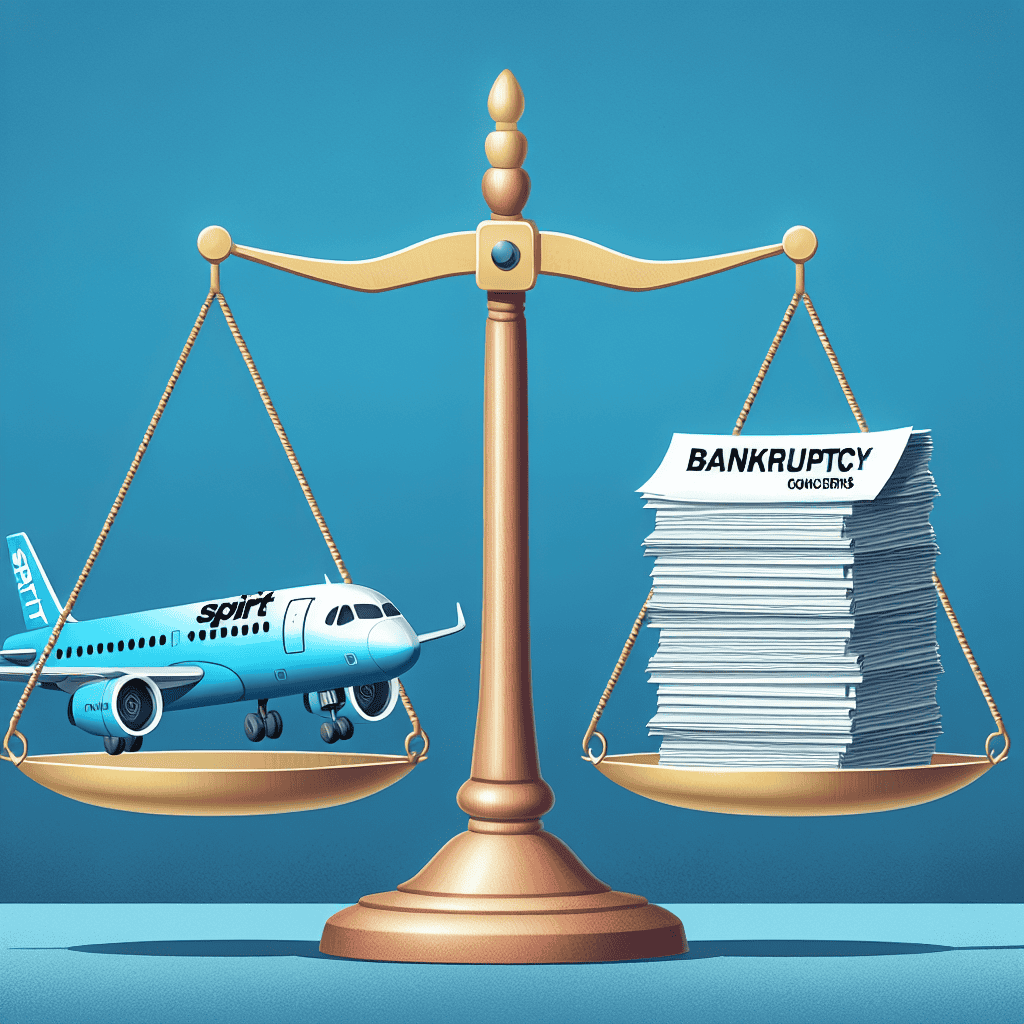“Navigating Turbulence: Weighing the Risks of Investing in Spirit Airlines Amid Bankruptcy Fears”
Introduction
Evaluating Spirit Airlines: A Risky Bet in Light of Bankruptcy Concerns
In the volatile landscape of the airline industry, Spirit Airlines has long been recognized for its ultra-low-cost business model, appealing to budget-conscious travelers with its no-frills approach. However, recent financial turbulence and market dynamics have raised significant concerns about the airline’s long-term viability, prompting investors and industry analysts to scrutinize its financial health and strategic direction. As the specter of bankruptcy looms, understanding the risks associated with investing in Spirit Airlines becomes crucial. This analysis delves into the factors contributing to the airline’s precarious position, examining its operational challenges, competitive pressures, and financial vulnerabilities to assess whether Spirit Airlines represents a risky investment in the current economic climate.
Financial Health Analysis: Understanding Spirit Airlines’ Current Position
Spirit Airlines, a prominent player in the ultra-low-cost carrier segment, has long been a subject of interest for investors and industry analysts alike. Known for its no-frills service and competitive pricing, Spirit has carved out a niche in the airline industry. However, recent concerns about its financial health have raised questions about the sustainability of its business model. To understand Spirit Airlines’ current position, it is essential to examine its financial performance, operational strategies, and the broader economic environment.
In recent years, Spirit Airlines has experienced both growth and challenges. On the one hand, the airline has expanded its route network and increased its market share by targeting cost-conscious travelers. This strategy has allowed Spirit to maintain a competitive edge in a highly saturated market. On the other hand, the airline industry is notoriously volatile, with external factors such as fluctuating fuel prices, economic downturns, and geopolitical tensions impacting profitability. Spirit Airlines is not immune to these pressures, and its financial statements reflect the complexities of operating in such an environment.
A closer look at Spirit’s financial performance reveals a mixed picture. The airline has consistently reported revenue growth, driven by increased passenger volumes and ancillary revenue streams such as baggage fees and seat selection charges. However, profitability has been under pressure due to rising operational costs and competitive pricing strategies. The airline’s cost structure, while lean, is susceptible to external shocks, particularly in fuel prices and labor costs. These factors have contributed to a tightening of profit margins, raising concerns about the airline’s ability to weather economic downturns.
Moreover, Spirit Airlines’ balance sheet provides further insight into its financial health. The airline has managed to maintain a relatively low level of debt compared to its peers, which is a positive indicator of financial prudence. However, liquidity remains a critical concern, especially in light of potential disruptions in cash flow. The airline’s cash reserves, while adequate for day-to-day operations, may not be sufficient to absorb prolonged periods of financial strain. This vulnerability underscores the importance of strategic financial management and contingency planning.
In addition to internal financial metrics, external factors play a significant role in shaping Spirit Airlines’ current position. The airline industry is subject to regulatory changes, shifts in consumer preferences, and technological advancements. Spirit’s ability to adapt to these changes will be crucial in determining its long-term viability. Furthermore, the competitive landscape is evolving, with traditional carriers enhancing their low-cost offerings and new entrants seeking to capture market share. Spirit must navigate these challenges while maintaining its value proposition to customers.
In conclusion, evaluating Spirit Airlines’ financial health requires a comprehensive analysis of both internal and external factors. While the airline has demonstrated resilience and adaptability, concerns about its financial stability persist. The potential for bankruptcy, though not imminent, cannot be entirely dismissed given the inherent risks in the airline industry. Investors and stakeholders must weigh these risks against the potential rewards, considering Spirit’s strategic initiatives and market position. Ultimately, Spirit Airlines’ future will depend on its ability to balance growth with financial discipline, ensuring that it remains a viable player in the competitive airline landscape.
Market Competition: How Spirit Airlines Stands Against Rivals
In the competitive landscape of the airline industry, Spirit Airlines has long been recognized for its ultra-low-cost business model, which has both attracted budget-conscious travelers and drawn criticism for its no-frills service. As the airline navigates the turbulent skies of market competition, recent concerns about its financial stability have raised questions about its ability to maintain its position against rivals. Evaluating Spirit Airlines in the context of its competitors requires a nuanced understanding of its operational strategies, market positioning, and the broader economic environment.
Spirit Airlines has carved out a niche by offering some of the lowest fares in the industry, a strategy that has enabled it to capture a significant share of the price-sensitive segment of the market. This approach, however, comes with inherent risks, particularly in times of economic uncertainty. The airline’s reliance on ancillary fees for services such as seat selection, baggage, and refreshments has been a double-edged sword. While these fees have bolstered revenue, they have also been a point of contention among passengers, potentially impacting customer loyalty and brand perception.
In comparison to its rivals, Spirit Airlines operates with a lean cost structure, which has historically allowed it to remain profitable even when facing headwinds such as fluctuating fuel prices and economic downturns. However, the airline’s aggressive cost-cutting measures, including its use of a single aircraft type to streamline maintenance and training, may not be sufficient to shield it from the financial pressures exacerbated by the COVID-19 pandemic and subsequent shifts in travel demand. As the industry gradually recovers, Spirit’s ability to adapt to changing consumer preferences and maintain operational efficiency will be critical.
Moreover, Spirit Airlines faces stiff competition from both legacy carriers and other low-cost airlines. Legacy airlines, with their extensive networks and established brand loyalty, have been increasingly encroaching on the low-cost market by offering competitive fares and enhanced service options. Meanwhile, other budget airlines, such as Frontier and Southwest, continue to vie for the same cost-conscious travelers, often matching or undercutting Spirit’s prices. This intensifying competition necessitates that Spirit not only maintains its cost advantage but also differentiates itself through customer experience and service innovation.
Adding to the complexity of Spirit’s competitive position are recent concerns about its financial health, with some analysts speculating about the possibility of bankruptcy. While the airline has taken steps to bolster its liquidity, such as securing financing and deferring aircraft deliveries, the specter of financial instability could undermine consumer confidence and deter potential investors. In this context, Spirit’s management faces the daunting task of reassuring stakeholders while executing a strategic plan that ensures long-term viability.
In conclusion, Spirit Airlines stands at a crossroads as it contends with formidable market competition and financial uncertainties. Its ultra-low-cost model, while advantageous in capturing a specific market segment, may not be sufficient to sustain its competitive edge in the face of evolving industry dynamics. As Spirit navigates these challenges, its ability to innovate, adapt, and communicate effectively with stakeholders will be pivotal in determining whether it can emerge as a resilient player in the airline industry or if it will remain a risky bet for investors and travelers alike.
Customer Experience: Evaluating Service Quality and Satisfaction
Spirit Airlines, a prominent player in the low-cost carrier segment, has long been a subject of debate among travelers and industry experts alike. As the airline faces potential bankruptcy concerns, evaluating its service quality and customer satisfaction becomes increasingly pertinent. Spirit Airlines has built its brand on offering budget-friendly fares, often undercutting competitors by significant margins. However, this cost-saving approach has led to a mixed reputation regarding customer experience. Understanding the nuances of Spirit’s service quality and customer satisfaction is essential for assessing whether flying with the airline is a risky bet.
To begin with, Spirit Airlines operates on an ultra-low-cost model, which inherently involves a no-frills approach to air travel. This model allows passengers to pay only for the services they need, such as seat selection, baggage, and in-flight refreshments. While this à la carte pricing structure can be advantageous for budget-conscious travelers, it often leads to dissatisfaction among those unaccustomed to such practices. Many passengers find themselves surprised by the additional fees, which can quickly accumulate and negate the initial savings on the ticket price. Consequently, this has led to a perception of Spirit as a “nickel-and-dime” airline, which can detract from overall customer satisfaction.
Moreover, Spirit Airlines has faced criticism for its customer service, which is a crucial component of the overall travel experience. Reports of delayed flights, limited customer support, and a lack of flexibility in accommodating passenger needs have been recurrent themes in customer reviews. These issues are often exacerbated during peak travel seasons when the airline’s resources are stretched thin. In such instances, passengers may find themselves stranded or facing long wait times for assistance, further diminishing their satisfaction with the airline.
Despite these challenges, it is important to acknowledge that Spirit Airlines has made efforts to improve its service quality. The airline has invested in newer aircraft, which offer more comfortable seating and enhanced in-flight amenities. Additionally, Spirit has implemented technology-driven solutions, such as mobile apps and self-service kiosks, to streamline the check-in process and reduce wait times. These initiatives indicate a commitment to enhancing the customer experience, although their impact on overall satisfaction remains a topic of debate.
Furthermore, Spirit Airlines’ operational efficiency is a factor that cannot be overlooked. The airline boasts a relatively high on-time performance rate compared to other low-cost carriers, which is a significant consideration for travelers prioritizing punctuality. This operational reliability can contribute positively to customer satisfaction, particularly for those who value timeliness over additional amenities.
In light of potential bankruptcy concerns, evaluating Spirit Airlines’ service quality and customer satisfaction becomes even more critical. Financial instability can lead to disruptions in operations, affecting everything from flight schedules to customer service availability. Passengers may find themselves facing increased uncertainty, which can further erode trust in the airline. Therefore, prospective travelers must weigh the potential risks against the benefits of low-cost fares when considering Spirit Airlines as their carrier of choice.
In conclusion, Spirit Airlines presents a complex picture when it comes to service quality and customer satisfaction. While the airline offers competitive pricing and operational efficiency, its no-frills model and customer service challenges can impact the overall travel experience. As bankruptcy concerns loom, travelers must carefully evaluate whether the potential savings justify the risks associated with flying Spirit. Ultimately, the decision hinges on individual priorities and tolerance for the trade-offs inherent in ultra-low-cost air travel.
Cost-Cutting Strategies: Assessing Their Impact on Long-Term Viability

Spirit Airlines, known for its ultra-low-cost business model, has long been a subject of debate among industry analysts and travelers alike. The airline’s cost-cutting strategies, while instrumental in offering competitive fares, have raised questions about its long-term viability, especially in light of recent bankruptcy concerns. To understand the potential risks and rewards associated with Spirit Airlines, it is essential to examine the impact of its cost-cutting measures on its operational efficiency and financial stability.
At the core of Spirit Airlines’ strategy is its ability to minimize operational costs. By employing a no-frills approach, the airline has successfully reduced expenses related to in-flight services, baggage handling, and ticketing. This model allows Spirit to offer lower base fares compared to its competitors, attracting price-sensitive travelers. However, this approach also necessitates additional fees for services that are typically included in the ticket price of other airlines, such as seat selection and carry-on luggage. While this strategy has proven effective in generating revenue, it has also led to customer dissatisfaction and a reputation for poor service quality.
Moreover, Spirit Airlines’ focus on cost reduction extends to its fleet management. The airline operates a single-type fleet of Airbus A320 family aircraft, which simplifies maintenance and training processes, thereby reducing costs. This uniformity allows for greater operational flexibility and efficiency. However, the reliance on a single aircraft type also poses risks, as any technical issues or regulatory changes affecting the A320 could have significant repercussions for the airline’s operations.
In addition to operational efficiencies, Spirit Airlines has implemented aggressive pricing strategies to maintain its market position. By offering deeply discounted fares, the airline aims to stimulate demand and increase load factors. While this approach can drive short-term revenue growth, it also exposes the airline to fluctuations in fuel prices and economic downturns. In times of financial strain, such as during the COVID-19 pandemic, Spirit’s low-margin model may struggle to absorb shocks, leading to concerns about its financial resilience.
Furthermore, Spirit Airlines’ cost-cutting measures have implications for its workforce. The airline’s emphasis on efficiency often translates to lower wages and benefits for its employees compared to industry standards. While this helps keep operational costs low, it can also result in high employee turnover and labor disputes, potentially affecting service quality and operational reliability.
Despite these challenges, Spirit Airlines has shown resilience in navigating the competitive airline industry. Its ability to adapt to changing market conditions and maintain a lean cost structure has allowed it to remain a formidable player in the low-cost carrier segment. However, the looming threat of bankruptcy raises questions about the sustainability of its business model. As the airline industry continues to evolve, Spirit must balance its cost-cutting strategies with investments in customer experience and operational robustness to ensure long-term viability.
In conclusion, Spirit Airlines’ cost-cutting strategies have been both a strength and a vulnerability. While they have enabled the airline to offer competitive fares and maintain a strong market presence, they also pose risks to its financial stability and service quality. As the airline faces potential bankruptcy concerns, it must carefully evaluate its approach to ensure it can withstand economic challenges and continue to thrive in the ever-changing aviation landscape.
Bankruptcy Risks: Identifying Warning Signs and Potential Outcomes
Spirit Airlines, a prominent player in the low-cost carrier segment, has long been a subject of interest for both investors and consumers. Known for its no-frills approach and competitive pricing, the airline has carved out a niche in the aviation industry. However, recent discussions surrounding its financial health have raised concerns about the potential risk of bankruptcy. Evaluating these concerns requires a careful examination of the warning signs and potential outcomes associated with such a scenario.
To begin with, one of the primary indicators of financial distress in any company is its liquidity position. For Spirit Airlines, maintaining adequate liquidity is crucial, given the capital-intensive nature of the airline industry. A dwindling cash reserve or an inability to meet short-term obligations could signal trouble. In recent financial reports, Spirit Airlines has shown fluctuations in its cash flow, which may raise red flags for investors. Moreover, the airline’s reliance on debt financing to support its operations and expansion plans further exacerbates these concerns. A high debt-to-equity ratio can limit financial flexibility, making it challenging to navigate economic downturns or unexpected disruptions.
In addition to liquidity issues, operational challenges can also contribute to bankruptcy risks. Spirit Airlines operates in a highly competitive market, where maintaining cost efficiency is paramount. Rising fuel prices, labor costs, and maintenance expenses can erode profit margins, putting additional strain on the airline’s financial stability. Furthermore, the airline’s business model, which focuses on offering low fares with additional fees for services, may face limitations in a market where consumer preferences are shifting towards more comprehensive service offerings. This shift could potentially impact Spirit’s ability to attract and retain customers, thereby affecting its revenue streams.
Another critical factor to consider is the broader economic environment. The airline industry is particularly sensitive to economic cycles, with downturns often leading to reduced travel demand. In the event of an economic recession, discretionary spending on travel tends to decline, which could adversely affect Spirit Airlines’ passenger volumes and load factors. Additionally, geopolitical tensions, regulatory changes, and unforeseen events such as pandemics can further complicate the operating landscape, posing additional risks to the airline’s financial health.
Despite these challenges, it is important to recognize that bankruptcy is not an inevitable outcome for Spirit Airlines. The company has several strategic options at its disposal to mitigate these risks. For instance, Spirit could explore cost-cutting measures, renegotiate debt terms, or seek additional capital through equity financing. Additionally, strategic partnerships or mergers with other carriers could provide synergies and enhance operational efficiencies. By leveraging its brand recognition and market position, Spirit Airlines could potentially navigate through financial turbulence and emerge stronger.
In conclusion, while the concerns surrounding Spirit Airlines’ financial health and potential bankruptcy risks are valid, it is essential to approach the situation with a balanced perspective. Identifying warning signs such as liquidity constraints, operational challenges, and economic vulnerabilities is crucial for stakeholders. However, it is equally important to consider the airline’s strategic initiatives and adaptability in addressing these challenges. Ultimately, the outcome will depend on Spirit Airlines’ ability to effectively manage its financial resources, adapt to changing market dynamics, and capitalize on growth opportunities. As the situation unfolds, stakeholders must remain vigilant and informed to make well-considered decisions regarding their involvement with the airline.
Investment Perspective: Weighing the Risks and Rewards of Spirit Airlines
Investing in the airline industry has always been a venture fraught with both potential rewards and inherent risks. Among the various players in this sector, Spirit Airlines has garnered attention for its ultra-low-cost business model, which has attracted a specific segment of budget-conscious travelers. However, recent concerns about the financial stability of Spirit Airlines have prompted investors to reevaluate the potential risks and rewards associated with this company. As the specter of bankruptcy looms over the airline, it is crucial to examine the factors contributing to its current predicament and assess whether investing in Spirit Airlines is a prudent decision.
To begin with, Spirit Airlines has carved out a niche in the competitive airline industry by offering no-frills, low-cost flights. This approach has allowed the airline to maintain a steady stream of passengers who prioritize affordability over luxury. By charging for additional services such as seat selection, baggage, and in-flight refreshments, Spirit has managed to keep its base fares significantly lower than those of its competitors. This strategy has been successful in attracting a loyal customer base, particularly during periods of economic uncertainty when travelers are more inclined to seek cost-effective options.
However, the very model that has driven Spirit’s growth also exposes it to vulnerabilities, particularly in times of financial distress. The airline’s reliance on ancillary fees means that any downturn in passenger numbers can have a disproportionate impact on its revenue. Moreover, the airline industry is notoriously sensitive to external factors such as fluctuating fuel prices, regulatory changes, and economic downturns, all of which can exacerbate financial instability. In recent times, the COVID-19 pandemic has further highlighted these vulnerabilities, as travel restrictions and reduced demand have severely impacted airlines worldwide, including Spirit.
In light of these challenges, concerns about Spirit Airlines’ financial health have intensified. The company’s balance sheet has come under scrutiny, with analysts pointing to its high debt levels and relatively low cash reserves as potential red flags. These financial indicators have fueled speculation about the possibility of bankruptcy, a scenario that would have significant implications for investors. While Spirit has taken steps to mitigate these risks, such as securing additional financing and implementing cost-cutting measures, the uncertainty surrounding its long-term viability remains a cause for concern.
Despite these challenges, it is important to consider the potential rewards that investing in Spirit Airlines might offer. The airline’s low-cost model, while risky, also positions it to capitalize on a rebound in travel demand as economic conditions improve. Furthermore, Spirit’s focus on domestic routes and leisure travel could prove advantageous in a post-pandemic landscape, where international travel may recover more slowly. Investors with a higher risk tolerance may view Spirit’s current valuation as an opportunity to acquire shares at a discount, banking on the airline’s ability to weather the storm and emerge stronger.
In conclusion, evaluating Spirit Airlines from an investment perspective requires a careful weighing of the risks and rewards. While the airline’s low-cost model and potential for growth present attractive opportunities, the financial challenges it faces cannot be overlooked. Investors must consider their own risk tolerance and conduct thorough due diligence before making any decisions. As the situation continues to evolve, staying informed about Spirit Airlines’ financial health and strategic initiatives will be crucial for those contemplating an investment in this potentially risky bet.
Future Outlook: Predicting Spirit Airlines’ Path in a Volatile Industry
Spirit Airlines, a prominent player in the ultra-low-cost carrier segment, has long been a subject of both admiration and skepticism within the aviation industry. As the airline navigates the turbulent skies of a volatile market, questions about its future viability have become increasingly pertinent, especially in light of recent bankruptcy concerns. To understand Spirit Airlines’ potential trajectory, it is essential to examine the factors influencing its current position and future prospects.
The airline industry is inherently susceptible to economic fluctuations, fuel price volatility, and regulatory changes. Spirit Airlines, with its business model centered on offering low fares and unbundled services, has managed to carve out a niche by appealing to cost-conscious travelers. However, this model also exposes the airline to significant risks, particularly when external conditions shift unfavorably. The recent economic downturn, exacerbated by the global pandemic, has intensified these challenges, leading to heightened scrutiny of Spirit’s financial health.
One of the primary concerns surrounding Spirit Airlines is its financial stability. The airline’s aggressive expansion strategy, while instrumental in capturing market share, has also resulted in a substantial debt burden. This financial strain, coupled with rising operational costs, has raised alarms about the airline’s ability to sustain its growth trajectory. Moreover, the competitive landscape in the low-cost carrier segment is becoming increasingly crowded, with new entrants and established players vying for the same customer base. This intensifying competition puts additional pressure on Spirit to maintain its cost advantage while delivering a satisfactory customer experience.
Despite these challenges, Spirit Airlines has demonstrated resilience in the face of adversity. The airline’s management has implemented several strategic initiatives aimed at bolstering its financial position and operational efficiency. For instance, Spirit has focused on optimizing its route network, enhancing its ancillary revenue streams, and investing in fuel-efficient aircraft. These measures are designed to improve profitability and mitigate the impact of external shocks. Furthermore, Spirit’s commitment to maintaining a lean cost structure provides a buffer against economic downturns, allowing it to remain competitive even in challenging times.
In addition to internal strategies, Spirit Airlines’ future outlook is also influenced by broader industry trends. The ongoing recovery of the travel sector, driven by pent-up demand and easing travel restrictions, presents a potential tailwind for the airline. As leisure travel rebounds, Spirit is well-positioned to capitalize on the resurgence of budget-conscious travelers seeking affordable options. However, the pace and sustainability of this recovery remain uncertain, with factors such as geopolitical tensions and fluctuating fuel prices posing potential headwinds.
In conclusion, while Spirit Airlines faces significant challenges, it also possesses opportunities to navigate the complexities of the aviation industry. The airline’s ability to adapt to changing market dynamics, coupled with its strategic initiatives, will be crucial in determining its future path. Investors and stakeholders must weigh the risks associated with Spirit’s business model against the potential rewards of its growth strategy. As the industry continues to evolve, Spirit Airlines’ journey will undoubtedly be a closely watched narrative, reflecting the broader dynamics of a volatile and ever-changing market.
Q&A
1. **What are the primary financial concerns surrounding Spirit Airlines?**
Spirit Airlines has faced financial challenges, including high debt levels, fluctuating fuel costs, and competitive pressures, which have raised concerns about its financial stability.
2. **How does Spirit Airlines’ business model impact its financial risk?**
Spirit Airlines operates as an ultra-low-cost carrier, which relies heavily on ancillary fees and cost-cutting measures. This model can be risky during economic downturns or when consumer demand shifts.
3. **What role does competition play in Spirit Airlines’ financial health?**
Intense competition from both low-cost and major airlines can pressure Spirit’s market share and pricing power, potentially impacting its revenue and profitability.
4. **How have external economic factors affected Spirit Airlines?**
Economic factors such as fuel price volatility, changes in consumer spending, and economic recessions can significantly impact Spirit’s operating costs and demand for air travel.
5. **What are the potential signs of bankruptcy risk for Spirit Airlines?**
Indicators of bankruptcy risk include declining revenue, increasing debt levels, inability to meet financial obligations, and negative cash flow trends.
6. **How does Spirit Airlines’ operational efficiency compare to its peers?**
Spirit Airlines is known for its operational efficiency, with a focus on maintaining low operating costs. However, this efficiency must be balanced with maintaining service quality and customer satisfaction.
7. **What strategic measures could Spirit Airlines take to mitigate bankruptcy risks?**
Spirit Airlines could focus on diversifying revenue streams, improving cost management, enhancing customer experience, and exploring strategic partnerships or mergers to strengthen its financial position.
Conclusion
Evaluating Spirit Airlines in the context of bankruptcy concerns reveals a complex risk profile. The airline’s low-cost business model and competitive pricing have historically attracted budget-conscious travelers, contributing to its market presence. However, the industry is highly susceptible to economic downturns, fluctuating fuel prices, and operational disruptions, which can exacerbate financial vulnerabilities. Spirit Airlines’ financial health must be scrutinized, considering its debt levels, cash flow, and ability to adapt to market changes. While potential mergers or acquisitions could offer strategic advantages, they also introduce integration risks. Ultimately, investing in Spirit Airlines requires careful consideration of these factors, balancing potential rewards against the inherent risks of the airline’s financial stability and market dynamics.





